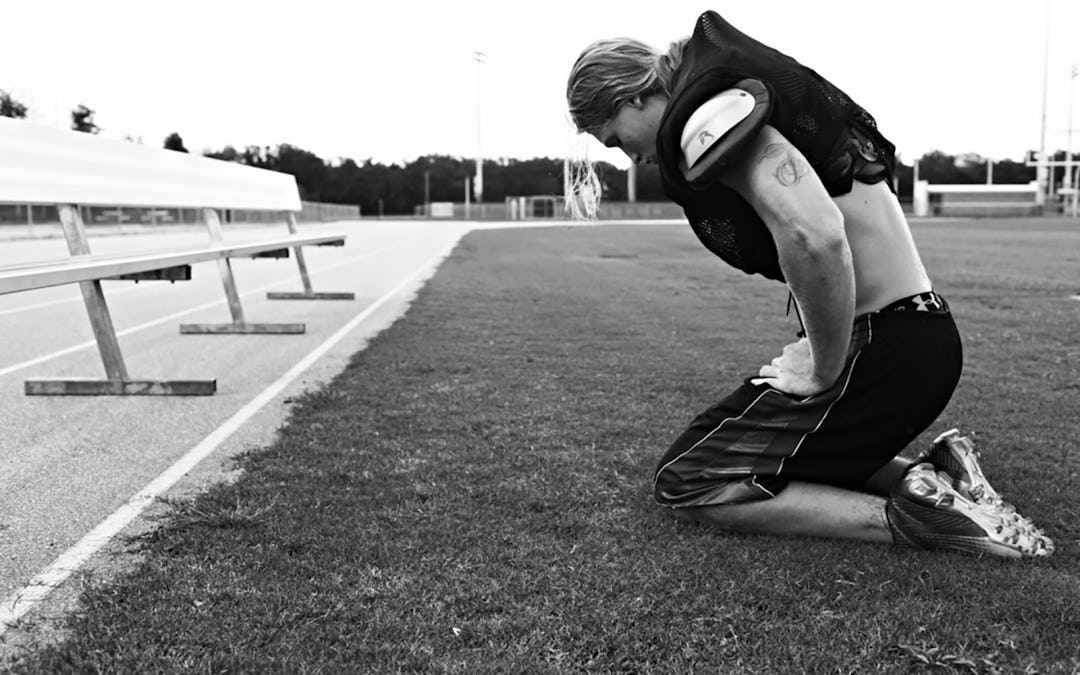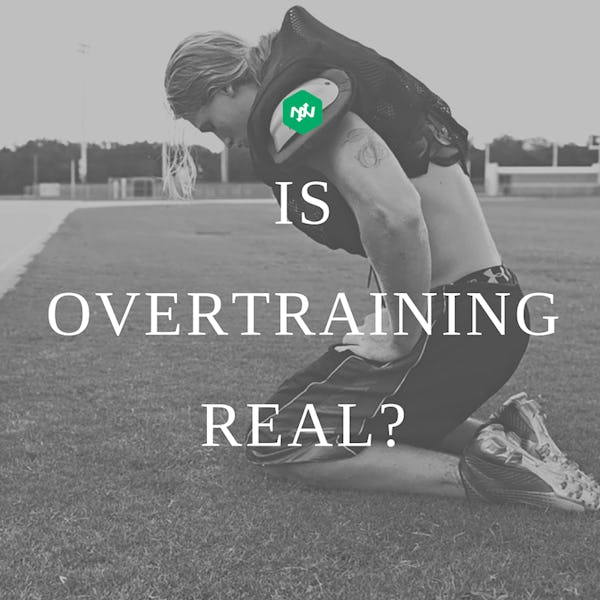I know all this despite what CT Fletcher may have led you to believe. But, now the response we get most often is:
“There is no such thing as Over-Training, just Under-Recovery.”
Every time I hear this bullshit I want to tie this person up and put them in a trunk of a large sedan for a couple weeks. I wouldn’t even tell them why they are there, just make them lie in the darkness, with their stupid.
Could you train more if you constantly foam rolled, got dry needled 6 times a week, and finished every day with a deep tissue massage? Yes, but where does this money train end and more importantly is it getting you results?
What if? Just what if that metabolic waste and damage you accumulate from exercise is meant to be there? What if in order for the body to adapt and thrive, it needs time to just wallow a bit in the suffering?
Our current culture loves to disrespect natural processes and rhythms, like darkness and sleep. Thus it makes sense that we would try to augment recovery to the nth degree. Like Coach Davis touched on in the previous article The Death of Superman, we are groomed from a young age to never forget that – more is always better.
If you read my last article on overtraining or if you have seen Dallas Buyers Club you know that this is not the case. Some drugs, vitamins, and even water are toxic at high dosages, yet at the right dosages they can help people in profound ways. The same goes for just about anything: sex, carbs, supplements, lifestyle factors, exercise, etc. The minimum effective dose. No more. No less.
In our industry, gyms, body workers, and supplement companies make a lot of money off this more is always more philosophy. For instance, no one makes any dinero by telling you to head home, go for silent walk in the woods, and then shut down your phone and get 8 hours of sleep. They increase profits by selling you more personal training sessions or classes you may not need or more mobility contraptions that end up in the dark recesses of your ass closet.
Again what if you got results and were only mildly sore? What if you took a back off week every month to enjoy life and rein in the gainz? Would you be ok with that or would you want your money back?
Ultimately, kicking the shit out of people is a Safety Net. If these athletes/humans don’t get the results they want, it cannot feasibly be the trainer’s or gym’s fault. They did everything within their power, literally everything ever. Writing random shit kickers on a white board and standing there yelling with a stopwatch is safe. It pacifies the population into thinking they did something unbelievably productive when really that coach has zero idea the individual stress he just put on any one of his or her human guinea pigs.
“Exhaustive intense training elicits a pronounced stress response as the athletes approach the upper limit of biological adaptation after three to four weeks. Continuation of such a program may lead to overtraining.”
– Dan John
How long you can stay in the fire just depends on something called vital reserve, but don’t get it twisted. Stay in long enough and you will burn.
Some of you may be thinking at this point, “Here they go again on this rampage against stupidity.” Well Superman, let’s just keep the opinions out of it and look to the science, both anecdotal and from the research setting. In order to do this, we need to cover what happens when we exercise and how our bodies recover from that stress to come back stronger, faster, and more resilient than before: AKA Train. Adapt¦Evolve
Muscle Damage
“All muscle actions (concentric, eccentric, isometric), appear to be capable of damaging muscle. This damage can be specific to just a few macromolecules or result in large tears in the z-disk, sarcolemma, basal lamina, and supportive connective tissue¦Exercise damages these structures when loading exceeds the limits the muscle is accustomed to.”
– Koch et al., 2014
When muscle is put under mechanical or metabolic stress, it releases enzymes such as creatine kinase (indicator of rhabdomyosis) and lactate dehyodrogenase and inflammatory cytokines such as (IL-1β, IL-6, IL-10, and TNF-α). These disturbances are catabolic and tell the body, “Hey we are breaking things down over here. Someone come fix this!”
After the stress has subsided the body then goes to work repairing the damage and hopefully building up the muscle and supportive structures bigger and more badass than before. That is WHY we train.
Limiting rest time, increasing volume or load, choosing multi-joint over isolated exercises all increase the degree of muscle damage. Not bad. Not good. Just dosing.
“Practical applications for the coach include cautious implementation of High Intensity/Short Rest protocols, as long-term sequential use may promote overtraining.”
– Szivak et al., 2014
Also, the stress response to exercise is highly individual. For example, people with higher body fat are generally higher responders, so it takes less of a stress to flood their system with this metabolic onslaught of enzymes, inflammation, and waste.
“The balance of both pro- and anti-inflammatory cytokines after exercise seems to be important for athletes. Optimal inflammatory and immune response may help optimize exercise regimes, link physical activity with health and diagnose or prevent athletes from overtraining.”
– Kimsa et al, 2014
That means monitoring and truly living by the minimum effective dose maxim to make sure that we are actually programming effectively and recovering appropriately between exercise bouts as well as microcycles and macrocycles¦seems legit.
Free Radical Production![Glycogen Depletion]()
Like a car giving off fumes when you run your metabolic engine, you are going to spit out reactive oxygen species (ROS) – more commonly known as free radicals. There is no stopping this. Free radical damage is powerful.
Too much can destroy mitochondria (your baby engines), membranes, and even DNA, but just the right amount is needed to signal an influx of those fancy enzymes that result in protein turnover – new gainz.
Not too much, not too little. Just right, Goldilocks.
Glycogen Depletion
When we exercise, we use fuel. In high intensity exercise that fuel is predominantly derived from glucose or sugar (we never really just run on one fuel, but this will suffice for the detail of this article).
We store glucose as glycogen in muscular tissue and the liver. As we continue to exercise, blood glucose levels drop as the need for insulin to transport glucose into muscle cells is decreased and glucose transporter concentration increases. In turn, a hormonal signal is generated that the body needs more energy STAT. This signal is marked with increased circulating cortisol, growth hormone, and other catecholamines.
Carbohydrate supplementation turns this blood sugar fiasco and increased cortisol ship around. That’s why combining high intensity exercise with a low carb diet is a recipe for overtraining. The fire never stops and you never really refuel. Disruptions in glucose homeostasis are believed to turn on the aforementioned inflammatory cytokine reaction, indicating the interplay and concert between all of these processes.
“Muscle and liver glycogen levels are critical variables for metabolic control during and after exercise.”
– Steinacker et al 2004
“One of the most essential things a person can do for the health and performance is work toward keeping blood sugar balanced.“
– Datis Kharrazian, DHSc, DC, MS, MNeuroSci, FAACP, DACBN, DABCN, DIBAK, CNS
Depressed Immune Function and Increased Risk of Autoimmunity
“Recent research evidence points to one system in particular being profoundly affected by overtraining; that system is the immune system.”
– Hackney, 2012
Our immune system is our defense against disease, both internal and external. Balance within this system may be the most critical for long-term health and even performance.
As you know muscular trauma from exercise results in the release of inflammatory cytokines. Cytokines are the language of the immune system and increased pro-inflammatory cytokines suppress cell mediated immunity which increases our risk of illness and infections. This is why you often hear old timers saying that one should feel somewhat sick at the end of a training cycle. They are using a lagging indicator (sickness) to identify what they hope is over-reaching.
Moreover, a constant or incessant state of inflammation can result in an immune system that is overactive and hyper-vigilant. A lot like the cop who takes his or her job too seriously, stopping speeders going 3 mph over during rush hour causing a traffic jam of onlookers.
Increased unchecked stress, from exercise or otherwise, sets the stage for autoimmunity in a number of ways in which it sees the host as a foreign invader. I don’t think anyone wants to come down with Hashimoto’s or inflammatory bowel disease due to beating the beat up at their local CrossFit gym. I will leave you to assess the gravity of this situation. You can think, “Oh, that won’t happen to me.” But what if it does, and you didn’t even PR your snatch? What a pity.
“Physical and psychological stress have been implicated in the development of autoimmune disease.”
– Stjanovich et al., 2008
Decreased Hormonal Response
Overtraining is marked with a distinct overall increase in cortisol and decreased pituitary output all due to the autonomic nervous system being in a chronic sympathetic dominant state. The hypothalamus and the pituitary are like the air traffic control tower for hormones in our bodies.
You piss off the pituitary with a constant swarm of stress hormones and it is going to put out the message – all flights are grounded. This means that cool stuff like growth, reproduction, libido, and higher level brain functioning are all shut down or slowed to a fraction of what they could be or once were.
Central Nervous System (CNS) Fatigue
“Muscular damage and metabolic needs are mainly involved in the acute training response and the chronic training response leads to changes not only in tissue metabolism, somatic growth or differentiation, body composition and organ function, but also to central regulatory disturbances.”
– Steinacker et al. 2004
Whenever we are in a sympathetic dominant state for too long, we start utilizing higher level brain outputs for rudimentary tasks. It’s like using the back of your $200 drill to pound in a nail because you can’t find your hammer. Not smart or maintainable.
Also, your central nervous system is the quickest to adapt to any outside stimulus like training. For example, it takes muscle tissue between 6 and 12 weeks to adapt, connective tissue can take years, but the nervous system adapts in seconds. If you piss it off long enough, it just won’t dig deep anymore. It will let you think you crushed it because it’s smarter than you, but little do you know that your high intensity training has really put a central governor on your ability to go HAM. Ironic.
“Practice going the distance, and you will teach your CNS to pace its efforts in order to last – so few recognize the dangers of a ’just trying to last’ mentality,”
– Barry Ross
Conclusion
There are close to 800 publications on the diagnosis, mechanisms, and effects of Over-Training. Respect the science. Respect biological rhythms. Respect your body. Reclaim your health. If you don’t, you will just end up in the graveyard of some idiot coach that we unfortunately could not find to lock up in the trunk of a rusted out Caprice Classic. We are trying. We need your help.
“The body has only so much adaptive capacity. Why tap it with volume and exercises that do not bring you closer to victory?”
– Pavel Tsatsouline
References
1. Brooks K, Carter J. Overtraining, Exercise, and Adrenal Insufficiency. Journal of novel physiotherapies. Feb 16 2013;3(125).
2. Gholamnezhad Z, Boskabady MH, Hosseini M, Sankian M, Khajavi Rad A. Evaluation of immune response after moderate and overtraining exercise in wistar rat. Iranian journal of basic medical sciences. Jan 2014;17(1):1-8.
3. Hackney AC. Clinical management of immuno-suppression in athletes associated with exercise training: sports medicine considerations. Acta medica Iranica. 2013;51(11):751-756.
4. Hackney AC, Koltun KJ. The immune system and overtraining in athletes: clinical implications. Acta clinica Croatica. Dec 2012;51(4):633-641.
5. Heavens KR, Szivak TK, Hooper DR, et al. The effects of high intensity short rest resistance exercise on muscle damage markers in men and women. J Strength Cond Res. Apr 2014;28(4):1041-1049.
6. Kimsa MC, Strzalka-Mrozik B, Kimsa MW, et al. Differential expression of inflammation-related genes after intense exercise. Prague medical report. 2014;115(1-2):24-32.
7. Koch AJ, Pereira R, Machado M. The creatine kinase response to resistance exercise. Journal of musculoskeletal & neuronal interactions. Mar 2014;14(1):68-77.
8. Lehmann MJ, Lormes W, Opitz-Gress A, et al. Training and overtraining: an overview and experimental results in endurance sports. The Journal of sports medicine and physical fitness. Mar 1997;37(1):7-17.
9. Li X, Huang WX, Lu JM, et al. Effects of a multivitamin/multimineral supplement on young males with physical overtraining: a placebo-controlled, randomized, double-blinded cross-over trial. Biomedical and environmental sciences : BES. Jul 2013;26(7):599-604.
10. Main LC, Dawson B, Heel K, Grove JR, Landers GJ, Goodman C. Relationship between inflammatory cytokines and self-report measures of training overload. Research in sports medicine. Apr 2010;18(2):127-139.
11. Meeusen R, Duclos M, Foster C, et al. Prevention, diagnosis, and treatment of the overtraining syndrome: joint consensus statement of the European College of Sport Science and the American College of Sports Medicine. Med Sci Sports Exerc. Jan 2013;45(1):186-205.
12. Pereira BC, Pauli JR, Antunes LM, et al. Overtraining is associated with DNA damage in blood and skeletal muscle cells of Swiss mice. BMC physiology. 2013;13:11.
13. Phillips GB, Yano K, Stemmermann GN. Serum sex hormone levels and myocardial infarction in the Honolulu Heart Program. Pitfalls in prospective studies on sex hormones. Journal of clinical epidemiology. 1988;41(12):1151-1156.
14. Steinacker JM, Lormes W, Reissnecker S, Liu Y. New aspects of the hormone and cytokine response to training. European journal of applied physiology. Apr 2004;91(4):382-391.
15. Stojanovich L, Marisavljevich D. Stress as a trigger of autoimmune disease. Autoimmunity reviews. Jan 2008;7(3):209-213.
16. Szivak TK, Hooper DR, Dunn-Lewis C, et al. Adrenal cortical responses to high-intensity, short rest, resistance exercise in men and women. J Strength Cond Res. Mar 2013;27(3):748-760.






)





